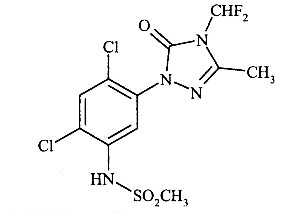Sulfentrazone
| Pesticide Type | Herbicide |
|---|---|
| Site of Action | PPO Inhibitor (Group 14) |
| Chemical Class | Aryl triazinone |
| Common Trade Names* | Apartan, Shutdown, Ambition, Authority premix products |
| Registration Status | EPA: Registered since 1987 MN: Registered |
| Structure |
|
*No endorsement is implied in the referencing of trade names.
Sulfentrazone is a selective soil-applied herbicide for control of annual broadleaf weeds and yellow nutsedge in a variety of crops including soybeans, sunflowers, dry beans, and dry peas1. It also suppresses some grass weeds however additional control measures are usually required. It can be applied early preplant, preplant incorporated, or preemergence and is a component in several preemergence herbicide premixes. In 2019, approximately 340,000 pounds of sulfentrazone were sold in Minnesota2.
Mode of Action
Sulfentrazone is in the aryl triazinone chemical class of herbicides and controls weeds by inhibiting the protoporphyrinogen oxidase (PPO) enzyme in plants1. PPO inhibitors, herbicide site-of-action 14, interfere with an enzyme involved in chlorophyll biosynthesis and leads to an accumulation of intermediates that are highly reactive when exposed to light resulting in membrane disruption3.
Issues with Resistance
Herbicide resistance is the inherited ability of a plant, such as weeds, to survive an herbicide application that the original population was susceptible to. The development of resistance is a growing concern for weed management because it can lead to the loss of herbicide options, which can have important economic and environmental consequences. Sulfentrazone resistant weeds have not been reported in Minnesota or surrounding states4. A population of resistant wild oats (Avena fatua) has been reported in Manitoba, Canada. To prevent the development of resistant weeds, use practices such as rotating and combining herbicide sites-of-action and utilizing mechanical weed control3.
Sulfentrazone Persistence and Movement in the Environment
Sulfentrazone is very persistent in the environment with a half-life of 1.5 years in soil under aerobic conditions5. It is relatively stable to hydrolysis and biodegradation; however, it is subject to rapid photodegradation on the soil surface or in clear shallow waters when exposed to sunlight. Sulfentrazone does not adsorb strongly to soil and has a high leaching potential (Koc = 43 mL/goc). It has a high potential to leach to groundwater or move offsite to surface water.
Detection in Minnesota Waters
The MDA monitors groundwater and surface water for sulfentrazone through its Agricultural Chemical Monitoring and Assessment Program. In 2020, sulfentrazone was detected in 10% of the 223 groundwater samples analyzed6. The maximum concentration detected was 1,900 ng/L, which is approximately 1% of the Minnesota Department of Health’s human health-based reference value of 200,000 ng/L7. Sulfentrazone was detected in 37% of the 386 surface water samples analyzed by MDA in 2020, with a maximum concentration of 3,440 ng/L6. The lowest EPA Office of Pesticide Programs (OPP) aquatic life benchmark for sulfentrazone is 28,800 ng/L (for vascular plants)8.
Water Quality Portal9 data for the Upper Midwest indicated that 8% of groundwater sampled between 2013 and 2020 had detections of sulfentrazone. Minnesota groundwater samples also had 8% detection frequency for sulfentrazone, including the maximum detection of 4,810 ng/L. The maximum detection was 2.4% of the Minnesota Department of Health reference value (200,000 ng/L). It was detected in 44% of Minnesota surface water samples with a maximum concentration of 2,710 ng/L.
Sulfentrazone and Non-target Organisms
Sulfentrazone is practically nontoxic to birds, mammals, and adult bees on an acute exposure basis. It is slightly to practically non-toxic to freshwater fish (bluegill [Lepomis macrochirus] LC50 = 93.8 mg a.i./L) and slightly toxic to freshwater invertebrates (Daphnia magna LC50 = 60.4 mg a.i./L)5.
Sulfentrazone can cause stunting of soybeans if excessive rain occurs between application and soybean emergence. Soybeans generally outgrow this injury, but some soybean varieties are more sensitive to this herbicide and can be severely injured. Spray drift can result in local necrotic tissue on nontarget plants10. Since sulfentrazone is a preemergence herbicide, large spray droplet size and low boom height can be utilized to reduce drift11.
Sulfentrazone and Human Health
Besides the acute toxicity mentioned, sulfentrazone shows no evidence of acute neurotoxicity, carcinogenicity, mutagenesis, or cytotoxicity. However, it is a mild eye irritant and applicators and handlers are required to wear chemical resistant clothing12.
References
1United States Environmental Protection Agency. December 2015. Sulfentrazone: Interim Registration Review Decision. Posted Jan 5, 2016.
2Minnesota Department of Agriculture. Pesticide Sales Database. Accessed 2020.
3Ohio State University Extension. 2020 Weed Control Guide for Ohio, Indiana, and Illinois. Bulletin 789.
4Heap, I. The International Herbicide-Resistant Weed Database. June 15, 2021.
5United States Environmental Protection Agency. June 11, 2014. Preliminary Ecological Risk Assessment for the Registration Review of Sulfentrazone and Proposed New Uses on Apples.
6Minnesota Department of Agriculture. 2020 Water Quality Monitoring Report.
7Minnesota Department of Health. Rapid Assessments for Pesticides. Accessed July 27, 2021.
8United States Environmental Protection Agency. Aquatic Life Benchmarks and Ecological Risk Assessments for Registered Pesticides. Accessed July 27, 2021
9National Water Quality Monitoring Council. Water Quality Portal. Accessed June 21, 2021.
10Iowa State University Extension. 2005. Herbicide Manual for Ag Professionals. Extension publication WC-92.
11Addendum to the Environmental Fate and Ecological Risk Assessment for the Sulfentrazone Registration Review. Environmental Protection Agency. August 9, 2015.
12United States Environmental Protection Agency. 2015. Sulfentrazone – Preliminary Human-Health Risk Assessment for Registration Review and the Risk Assessment for the Section 3 Registration Request for a New Use on Apples.


